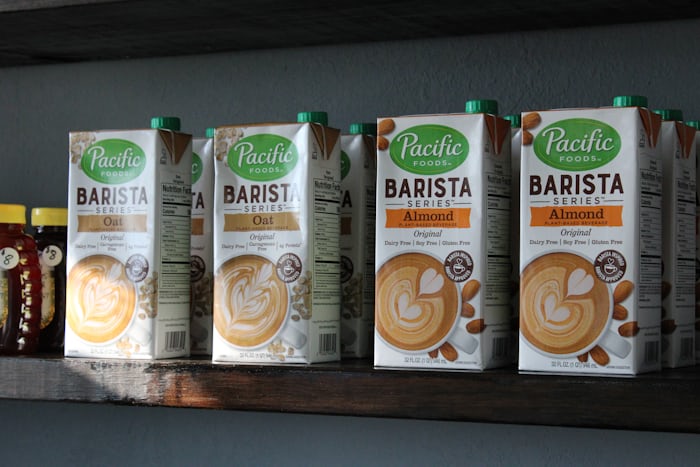Table of Contents
Have you accidentally drank spoiled almond milk? This common mishap can leave you with questions and concerns about potential health implications. While consuming spoiled almond milk isn’t ideal, understanding the risks and knowing how to respond can help ease your worries. In this article, we’ll explore what happens when almond milk goes bad, potential symptoms to watch for, and steps to take if you’ve consumed spoiled product.

We’ll also provide expert advice on proper storage and how to identify spoilage before it becomes a problem. Whether you’re a long-time almond milk enthusiast or new to plant-based alternatives, this information will help you navigate the world of non-dairy milk safely and confidently.
Signs of Spoiled Almond Milk: What to Look Out For
If you’ve accidentally drank spoiled almond milk, you’re not alone. Many people have found themselves in this situation, often because the signs of spoilage in plant-based milks can be subtle. To avoid accidentally drinking spoiled almond milk in the future, it’s crucial to know what indicators to check for before consuming.
- Visual Cues: One of the first signs that you may have accidentally drank spoiled almond milk is an unusual appearance. Fresh almond milk typically has a smooth, creamy color. If you notice any discoloration, such as yellowing or dark spots, it’s likely that the almond milk has spoiled. Additionally, if you see any mold growing on the surface or sides of the container, do not consume the product.
- Texture Changes: Another indicator that you might have accidentally drank spoiled almond milk is an altered texture. Fresh almond milk should pour smoothly and have a consistent texture throughout. If you notice any clumping, separation, or a thick, slimy consistency, these are signs that the almond milk has gone bad.
- Odor: Your nose can be a powerful tool in detecting spoiled almond milk. Fresh almond milk has a mild, slightly sweet aroma. If you’ve accidentally drank spoiled almond milk, you may have noticed a sour, rancid, or “off” smell before consuming. Always give your almond milk a sniff before drinking, especially if it’s been opened for a few days.
- Taste: While we hope you haven’t accidentally drank spoiled almond milk, if you have, you may have noticed an unpleasant taste. Fresh almond milk should have a light, nutty flavor. If it tastes sour, bitter, or unusually strong, it’s best to discard it.
- Expiration Date: While not foolproof, checking the expiration date can help prevent accidentally drinking spoiled almond milk. However, once opened, almond milk typically lasts 7-10 days in the refrigerator, regardless of the printed date. Always mark the date you opened the container to keep track.
- Packaging Integrity: Before consuming, check if the packaging is swollen or damaged. A bulging carton can indicate bacterial growth, which could lead to accidentally drinking spoiled almond milk if not noticed.
By familiarizing yourself with these signs, you can reduce the chances of accidentally drinking spoiled almond milk in the future. Remember, when in doubt, it’s always safer to discard the product rather than risk consuming spoiled almond milk.

Potential Health Risks of Consuming Spoiled Almond Milk
While almond milk is a popular dairy alternative, consuming it after it has spoiled can lead to certain health risks. Understanding these potential issues can help you make informed decisions about your almond milk consumption and know what to watch for if you’ve accidentally consumed spoiled product.
Foodborne Illness: The primary concern with drinking spoiled almond milk is the risk of foodborne illness. When almond milk goes bad, it can become a breeding ground for harmful bacteria such as Listeria, E. coli, or Salmonella. These microorganisms can cause a range of symptoms, from mild discomfort to more severe health issues. Common symptoms of foodborne illness include:
• Nausea
• Vomiting
• Diarrhea
• Abdominal pain
• Fever
• Headache
These symptoms typically appear within a few hours to a few days after consuming the spoiled product.
Digestive Discomfort: Even if the spoiled almond milk doesn’t contain harmful bacteria, it can still cause digestive issues. The breakdown of nutrients in spoiled almond milk can lead to:
• Bloating
• Gas
• Stomach cramps
• Indigestion
Allergic Reactions: In rare cases, consuming spoiled almond milk might trigger an allergic reaction, especially in individuals with nut allergies or sensitivities. This is because the spoilage process can alter proteins in the milk, potentially making them more allergenic. Signs of an allergic reaction may include:

• Hives or skin rash
• Itching or tingling in the mouth
• Swelling of the lips, tongue, or throat
• Difficulty breathing
Nutritional Concerns: While not an immediate health risk, it’s worth noting that spoiled almond milk loses its nutritional value. The vitamins and minerals that make almond milk a healthy choice begin to degrade as the product spoils, reducing its nutritional benefits.
Vulnerable Populations: It’s important to note that certain groups may be at higher risk for complications from consuming spoiled almond milk:
• Young children
• Elderly individuals
• People with weakened immune systems
These groups should be especially cautious about consuming any potentially spoiled foods, including almond milk.
Prevention is Key
The best way to avoid these health risks is to prevent consuming spoiled almond milk in the first place. Always check for signs of spoilage before drinking, store your almond milk properly in the refrigerator, and consume it within the recommended timeframe after opening.
Remember, if you suspect you’ve consumed spoiled almond milk and experience persistent or severe symptoms, it’s always best to consult with a healthcare professional. While most cases of consuming spoiled almond milk result in minor discomfort, it’s better to err on the side of caution when it comes to your health.

Immediate Steps to Take After Drinking Spoiled Almond Milk
Realizing you’ve just consumed spoiled almond milk can be alarming, but don’t panic. Here are some immediate steps you can take to minimize potential health risks and discomfort:
- Stop Drinking Immediately: If you notice an off taste, smell, or appearance while drinking almond milk, stop consuming it right away. This can help limit the amount of potentially harmful bacteria entering your system.
- Rinse Your Mouth: Thoroughly rinse your mouth with water to remove any remaining spoiled almond milk. This can help reduce the lingering bad taste and minimize the amount of bacteria in your mouth.
- Stay Hydrated: Drink plenty of water. Staying hydrated is crucial, especially if you develop symptoms like vomiting or diarrhea. Water can help flush your system and prevent dehydration.
• Monitor Your Symptoms: Pay close attention to how you feel over the next 24-48 hours. Common symptoms to watch for include:
– Nausea
– Stomach cramps
– Diarrhea
– Vomiting
– Fever
- Consider Probiotics: If you have them on hand, taking a probiotic supplement or eating probiotic-rich foods like yogurt might help. Probiotics can support your digestive system and potentially help combat harmful bacteria.
- Rest: Give your body time to recover. If you’re feeling unwell, take it easy and get plenty of rest.
- Avoid Certain Foods: If you’re experiencing digestive discomfort, it’s best to avoid rich, fatty, or spicy foods that might further upset your stomach.
• Use Over-the-Counter Remedies: For mild symptoms, over-the-counter medications might help:
– Anti-diarrheal medication if needed
– Oral rehydration solutions to replace lost fluids and electrolytes.
- Preserve Evidence: If you still have the spoiled almond milk, don’t discard it immediately. Keep it refrigerated in case you need to seek medical attention and your healthcare provider wants to test it.

Common Symptoms and When to Seek Medical Attention
After consuming spoiled almond milk, it’s crucial to be aware of potential symptoms and know when professional medical help is necessary. Here’s what you need to know:
Common Symptoms:
- Nausea: You might feel queasy or have an upset stomach.
- Vomiting: Your body may try to expel the spoiled milk.
- Diarrhea: Loose or watery stools are common reactions.
- Abdominal pain or cramps: You might experience discomfort in your stomach area.
- Fever: A low-grade fever might develop as your body fights off potential bacteria.
- Headache: This can be a result of dehydration or your body’s response to harmful bacteria.
Most of these symptoms are mild and should resolve within 24-48 hours. However, severe or persistent symptoms warrant medical attention.
When to Seek Medical Help:
- Severe abdominal pain that doesn’t improve
- Bloody stools
- High fever (over 101.5°F or 38.6°C)
- Symptoms lasting more than 3 days
- Signs of dehydration (dark urine, dizziness, dry mouth)
- Difficulty breathing or swallowing (possible signs of an allergic reaction)
Remember, it’s always better to err on the side of caution. If you’re unsure about the severity of your symptoms or have any underlying health conditions, consult with a healthcare professional.

Prevention: Proper Storage and Shelf Life of Almond Milk
Unopened Almond Milk
- Shelf-stable varieties can be stored at room temperature until the “best by” date.
- Refrigerate within 7-10 days of the “best by” date for freshness.
- Check for signs of spoilage before consuming, even if within the expiration date.
Opened Almond Milk
- Refrigerate immediately after opening.
- Consume within 7-10 days of opening.
- Store at 40°F (4°C) or below to slow bacterial growth.-
Proper Storage Tips
- Store in the main body of the fridge, not the door.
- Always reseal the container tightly.
- Use clean utensils to avoid contamination.
- Follow the “first in, first out” rule.
- Check for unusual odors, discoloration, or texture changes before use.
- Mark the opening date on the carton to track freshness.
- Freeze almond milk in ice cube trays for longer storage.-
Understanding Dates on Packaging
- “Best By” or “Use By”: Indicates peak quality, not safety. Can be consumed shortly after if stored properly.
- “Sell By“: Almond milk can last 5-7 days past this date if refrigerated properly.
Follow Gilcare On:

